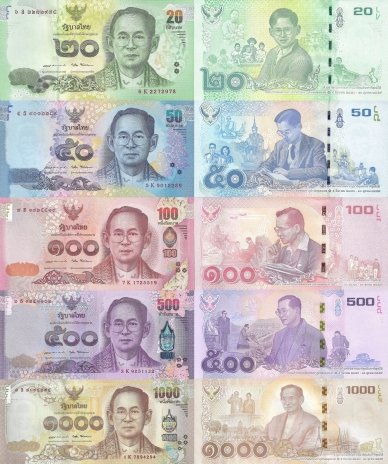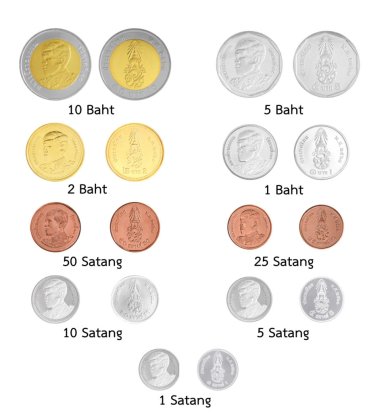The Thai Baht

The Thai Baht (THB, (฿) is the official currency of the Kingdom of Thailand. It does not belong to reserve and freely convertible currencies and circulates only within the country.

History
In 1928, the Thai Baht replaced the Siamese tikal, a means of payment in some Asian countries (Siam — modern Thailand, Burma — modern Myanmar, and Cambodia) after the 14th century.
However, the word baht was used as a local Cambodian and Siamese name of the tikal.
The latter has a Portuguese origin. Former colonisers of Indochina used it to measure silver in money. A Siamese coin equalled half of the Troy ounce (14-16.5 grams).
The money of Siam had an unusual design till the 1860s. It was a heavy convex bar of gold or silver weighing 1.2 kg.
In 1860, the design changed completely: the coins became flat and round and resembled the European ones. They were made of gold, silver, zinc, and copper and called riens. Now they circulate as the national currency of Cambodia under the name riel.
The riens existed till 1898. That year, the government announced the shift to the decimal calculation system, uncomplicated and understandable.
The transition period took four years. Eventually, in 1902, one tikal equalled 15,0333 grams of pure silver. It also got its fractional coin — satang, which has remained in circulation to date. One Thai baht consists of 100 satang.
Apart from metal coins, between 1853 and 1918, the tikal and the tamlueng were issued too. The latter was equal to the quarter of the tikal.
In 1928, the tikal and baht interchanged. It meant that the baht became the official currency and has retained the status up to this day. The tikal is the second, non-official name. The Bank of Thailand is the issuer of the TNB.
There have been 17 regular series of banknotes for the entire period of the Thai baht existence. The last one emerged in 2018. Besides, there are 19 series of commemorative banknotes and metal coins.
Design
Banknotes of the Thai baht are of a bright and unusual design affected by the national motives. An indispensable element of any banknote is a portrait of the ruling monarch.
Most commemorative banknotes emerged as tributes to events significant for the royal family. The Thais highly respect the dynasty and regard their King as a divine being.
Interestingly, not all commemorative banknotes can be used for purchases and payments. Many were released merely as tributes to landmark events and thus are not legal tender.
At present, only three series of the Thai baht are in circulation: the 15th, 16th, and 17th.
The quality of banknotes is constantly improved. Paper money also includes the mark for those who have poor eyesight. The surface of the Thai money is rough due to specific printing technology, which is a peculiar way of spraying the paint.
The 17th-series banknotes were issued between April and July 2018 and consist of five denominations of 20, 50, 100, 500, and 1,000 baht. Their dimensions include the width of 72 mm and the varying length.

Thai baht banknotes 17th series
All banknotes feature the portrait of the ruling monarch Rama X (Vajiralongkorn).
- 20 TNB is a green banknote, 138 mm long.
- 50 TNB - is a blue banknote, 144 mm long.
- 100 TNB is a red banknote, 150 mm long.
- 500 TNB is a purple banknote, 156 mm long.
- 1,000 TNB is a brown banknote, 164 mm long.
Coins
The fractional coin in Thailand is the satang. At present, there circulates fractional metal currency in the denominations of 25 and 50 satang. The coins of 1, 5, or 10 satang are used very rarely.
Besides, the coins of ฿1, ฿2, ฿5, and ฿10 are in circulation too. They are minted of steel alloys by the Royal Thai Mint. The satang is made of aluminum (97%-98%) with the addition of magnesium and other metals.

Thai baht coins
Circulation in the World
The Thai baht has a fluctuating exchange rate that is stable enough due to the low inflation rate. The TNB-USD exchange rate is 33.89:1, and the TNB-EUR is 38.26.
FAQ
Why is the Thai currency called baht?
The Thai currency is called "baht" because the term historically referred to a traditional unit of weight, which was used as a standard for trading gold and silver.
When did the Thai baht come into existence?
The Thai baht was officially adopted as the currency of Thailand in 1928.
What is the symbol and code of the Thai baht?
The symbol for the Thai baht is "฿," and its ISO currency code is "THB."
Is the Thai baht a stable currency?
The Thai baht's stability varies and depends on economic conditions. It has experienced periods of stability as well as volatility, influenced by domestic and international economic factors.
Who is depicted on Thai baht banknotes?
Thai baht banknotes commonly feature images of the current or past Kings of Thailand, particularly King Bhumibol Adulyadej (Rama IX) and currently King Maha Vajiralongkorn (Rama X).
What are the different types of Thai baht?
The Thai baht comes in both coin and banknote form. Coins are issued in denominations of 1, 2, 5, and 10 baht, as well as smaller denominations called satang (25 and 50 satang). Banknotes are issued in denominations of 20, 50, 100, 500, and 1,000 baht.







